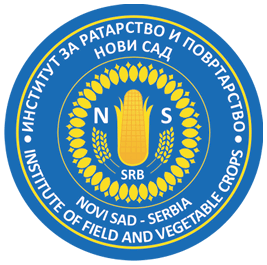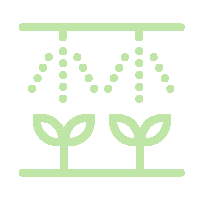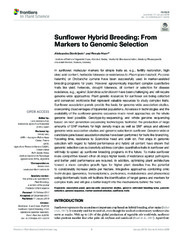Prikaz osnovnih podataka o dokumentu
Sunflower Hybrid Breeding: From Markers to Genomic Selection
| dc.creator | Dimitrijević, Aleksandra | |
| dc.creator | Horn, Renate | |
| dc.date.accessioned | 2021-04-26T19:39:36Z | |
| dc.date.available | 2021-04-26T19:39:36Z | |
| dc.date.issued | 2018 | |
| dc.identifier.issn | 1664-462X | |
| dc.identifier.uri | http://fiver.ifvcns.rs/handle/123456789/1783 | |
| dc.description.abstract | In sunflower, molecular markers for simple traits as, e.g., fertility restoration, high oleic acid content, herbicide tolerance or resistances to Plasmopara halstedii, Puccinia helianthi, or Orobanche cumana have been successfully used in marker-assisted breeding programs for years. However, agronomically important complex quantitative traits like yield, heterosis, drought tolerance, oil content or selection for disease resistance, e.g., against Sclerotinia sclerotiorum have been challenging and will require genome-wide approaches. Plant genetic resources for sunflower are being collected and conserved worldwide that represent valuable resources to study complex traits. Sunflower association panels provide the basis for genome-wide association studies, overcoming disadvantages of biparental populations. Advances in technologies and the availability of the sunflower genome sequence made novel approaches on the whole genome level possible. Genotype-by-sequencing, and whole genome sequencing based on next generation sequencing technologies facilitated the production of large amounts of SNP markers for high density maps as well as SNP arrays and allowed genome-wide association studies and genomic selection in sunflower. Genome wide or candidate gene based association studies have been performed for traits like branching, flowering time, resistance to Sclerotinia head and stalk rot. First steps in genomic selection with regard to hybrid performance and hybrid oil content have shown that genomic selection can successfully address complex quantitative traits in sunflower and will help to speed up sunflower breeding programs in the future. To make sunflower more competitive toward other oil crops higher levels of resistance against pathogens and better yield performance are required. In addition, optimizing plant architecture toward a more complex growth type for higher plant densities has the potential to considerably increase yields per hectare. Integrative approaches combining omic technologies (genomics, transcriptomics, proteomics, metabolomics and phenomics) using bioinformatic tools will facilitate the identification of target genes and markers for complex traits and will give a better insight into the mechanisms behind the traits. | en |
| dc.publisher | Frontiers Media Sa, Lausanne | |
| dc.relation | University of Rostock | |
| dc.relation | German Research Foundation (DFG) [HO 1593/5-1, HO 1593/5-2, HO 1593/6-1] | |
| dc.relation | info:eu-repo/grantAgreement/MESTD/Technological Development (TD or TR)/31025/RS// | |
| dc.rights | openAccess | |
| dc.rights.uri | https://creativecommons.org/licenses/by/4.0/ | |
| dc.source | Frontiers in Plant Science | |
| dc.subject | association panel | en |
| dc.subject | genome-wide association studies | en |
| dc.subject | genomic estimated breeding value | en |
| dc.subject | genomic selection | en |
| dc.subject | genome sequence | en |
| dc.subject | marker-assisted selection | en |
| dc.subject | sunflower | en |
| dc.subject | traits | en |
| dc.title | Sunflower Hybrid Breeding: From Markers to Genomic Selection | en |
| dc.type | article | |
| dc.rights.license | BY | |
| dc.citation.other | 8 | |
| dc.citation.rank | aM21 | |
| dc.citation.volume | 8 | |
| dc.identifier.doi | 10.3389/fpls.2017.02238 | |
| dc.identifier.fulltext | http://fiver.ifvcns.rs/bitstream/id/705/1780.pdf | |
| dc.identifier.pmid | 29387071 | |
| dc.identifier.scopus | 2-s2.0-85041310114 | |
| dc.identifier.wos | 000422672300001 | |
| dc.type.version | publishedVersion |


